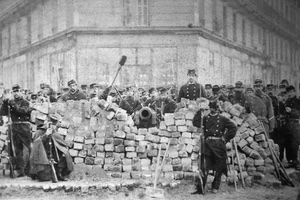‘There was a wall. It did not look important…’ – Ursula Le Guin, The Dispossessed
‘[We seek]…a world without borders, where no one is prevented from moving because of where you were born, or because of race, class or economic resources…’ – No Borders UK
‘We resolve…to strengthen control over our territories and to not permit the entry of any government functionary nor of a single transnational corporation.’ – The Confederation of Indigenous Nationalities of Ecuador
Borders are a key feature of our present. Whether national, regional, physical, electronic, cognitive, performative or cultural, they unevenly regulate the movement of bodies, ideas, objects, capital and bytes. Geopolitical borders are frequently sites of domination, but they may also provide solace for oppressed groups, some of whom actively call for or construct borders so they might protect their ways of living and advance their struggles. Conceptual borders allow us to grasp a complex world, but may inhibit understanding, communication and change. Temporal borders, meanwhile, seek to fix history into discrete categories of past, present and future.
Yet borders are not permanent. They remain a key site of contestation and struggle; and must continually be remade through technology, performance and often violence. And border crossings transform subjects, the space-times they leave, and the space-times they enter; as well as borders themselves. This means that utopianism – praxis that seeks to transform space and time – has much to offer contemporary ways of relating to borders. It can educate our desire for alternatives, and by showing us these alternatives – in fiction, theory or practice – estrange us from borders as they currently exist. The need for utopian rethinking and contestation of borders strikes us as particularly urgent given the current refugee crisis in Europe, and the continued role of borders in neocolonial dispossession around the world. Yet, whilst a utopian lens may have much to offer the thinking and practice of borders, this does not mean that the utopian is without borders of its own. Indeed, despite a turn to ‘the horizon’ and process in recent utopian theory, borders play a key role in many fictional utopias and dystopias; in ‘real world’ utopian communities; and in definitions of utopia itself.
The work presented here was supported by the Leverhulme International Research Network Imaginaries of the Future: Historicising the Present (2014-2017), which was dedicated to thinking through how we (might) think about the future. The network did not advance specific visions of the future as such, but rather sought to develop strategies for conceptualising ‘the future’ without doing violence to the bodies that might inhabit and (re)produce it. Its focus was utopian rather than futurological, and it was grounded in the knowledge that the utopian cannot be reduced to the fanciful, impossible or authoritarian. Many of the articles in this collection were presented at one of the network's six symposia, and all adhere to the spirit of the network. This collection in particular draws on papers presented at or which resonate with the network's 'Utopia at the Border' symposium, held at the University of Regensburg in 2016, in collaboration with network partner Kenneth Hanshew, of the University of Regensburg.
Two further volumes are in publication with the Open Library of Humanities: Bodies and Media and Politics, Poetics, Place.
This Special Collection was co-edited by Dr Nathaniel Coleman, Imaginaries of the Future Research Lead and Dr David M. Bell, Imaginaries of the Future Network Facilitator (2015-17)
Featured image, "Barricade à l'angle des boulevard Voltaire et Richard-Lenoir pendant la Commune de Paris de 1871," within the public domain.
Imaginaries of the Future 03: Utopia at the Border
Special Collections
-
Diversity and Competition within the Latin Church: The Secular-Mendicant Controversy and its Long Aftermath (13th–20th Centuries)
Thinking the Political: Theory, Literature, Practice
Poetry Off the Page: Intersecting Practices and Traditions in British Poetry Performance
Humour as a Human Right
Cultural Heritage Data for Research: Opening Museum Collections, Project Data and Digital Images for Research, Query and Discovery
Literature as Imaginary Archive: Ephemera and Modern Literary Production
Caliban's Mirror: Reflections of James Joyce and Oscar Wilde
Cultural Representations of Machine Vision
The Public Curatorship of the Medieval Past
Medieval Minds and Matter
Representing the Medieval in Popular Culture: Remembering the Angevins
The Politics and History of Menstruation: Contextualising the Scottish Campaign to End Period Poverty
Production Archives 03: Archival Practices
Production Archives 02: Production Contexts
Production Archives 01: Puppets for Action
Representing Classical Music in the Twenty-First Century
The Pathological Body: European Literary and Cultural Perspectives in the Age of Modern Medicine
Binary Modernisms: Re/Appropriations of Modernist Art in the Digital Age
Local and Universal in Irish Literature and Culture
Reading in Ruins: Exploring Posthumanist Narrative Studies
The Language of Perspective
Nancy Astor, Public Women and Gendered Political Culture in Interwar Britain
The Working-Class Avant-Garde
Colonialities in Dispute: Discourses on Colonialism and Race in the Spanish State
Powering the Future: Energy Resources in Science Fiction and Fantasy
Writers and Intellectuals on Britain and Europe, 1918–2018
Literature, Law and Psychoanalysis
Muslims in the Media
Encounters between Asian and Western Art in the 20th and 21st centuries: a liberating influence for Asia?
Waste: Disposability, Decay, and Depletion
Pride Revisited: Cinema, Activism and Re-Activation
New Approaches to Late Medieval Court Records
Utopian Art and Literature from Modern India
Right-Wing Populism and Mediated Activism: Creative Responses and Counter-Narratives
Representing Climate: Local to Global
Cultivating Spheres: Agriculture, Technical Communication, and the Publics
Freedom After Neoliberalism
The Medieval Brain
Remaking Collections
New Approaches to Medieval Water Studies
Imaginaries of the Future 01: Bodies and Media
Imaginaries of the Future 02: Politics, Poetics, Place
Imaginaries of the Future 03: Utopia at the Border
Postcolonial Perspectives in Game Studies
Station Eleven and Twenty-First-Century Writing
#Agreement20
What’s Left? Marxism, Literature and Culture in the 21st Century
New Voices in Jewish-American Literature
Authors, Narratives, and Audiences in Medieval Saints’ Lives
From TV To Film
American Literature & the Transnational Marketplace
Mnemosyne
Healing Gods, Heroes and Rituals in the Graeco-Roman World
The Abolition of the University
